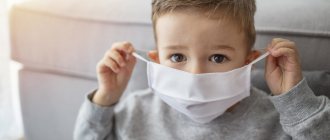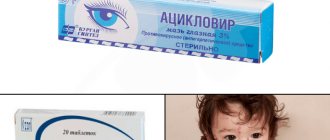Allergies in a child can occur at any time; the reason for this can be direct contact with allergens. It can manifest itself in the form of a rash on the body or a runny nose, and very often such symptoms are perceived as symptoms of acute respiratory infections or other ailments. As a result, the medications that parents try to treat the child with do not bring a positive result. There are several ways to determine what your child is allergic to and begin to treat it correctly.
Causes of the disease - the first stage, how to determine what a child is allergic to
A child's immunity is established in the womb. Her diet during pregnancy largely determines whether her child will develop a disease such as allergies in the future. During pregnancy, mothers should not abuse foods that are aggressive to the immune system of the unborn child: citrus fruits, eggs, chocolate and others. Before treating a child’s allergy, the causative agent, that is, the root cause, should be identified. The cause of the baby's illness can be early weaning and transfer to artificial feeding. Untimely introduction of complementary foods can also provoke the disease. The baby’s digestive system develops very slowly and cannot always accept the foods that the baby is given, causing allergic reactions. When the first symptoms appear, you need to contact a pediatric allergist.
Allergies are mostly an acquired disease, but there is also a possibility that it can be hereditary. It depends on whether anyone in the family suffers from the disease. There are many factors that trigger allergies.
- Allergies are common in infants, which can be caused by feeding formula or any cosmetics used to care for the baby’s skin. The risk of allergies is much lower when the baby is breastfed, since breast milk provides a balanced diet.
- Disturbed intestinal microflora. The cause may be prolonged use of antibiotics, as a result of which beneficial microflora is killed.
- Poor nutrition, the child consuming foods that often cause allergies, such as chocolate, eggs, strawberries or citrus fruits. Also, do not allow your child to consume a lot of sweets, fast food or carbonated drinks.
- Possible causes include the child’s weakened immune system and hormonal imbalance as a result of certain diseases.
Allergies in a newborn
In infants, allergic reactions can occur as a result of improper nutrition of the mother, and there is a misconception that a woman’s nutrition during pregnancy and lactation has nothing to do with the composition of milk. It is dangerous to think this way, since the abuse of foods that cause allergies by a pregnant woman increases the risk of illness in the child. Flavorings or food colors present in food products can also cause specific reactions in the body. In newborns, allergies are caused by unsuitable diapers or skin care products and exposure to urine. In the first years of life, a child is most susceptible to food allergies. And allergies to medications often occur in preschool children. If the child is not examined in time and complex treatment is not started, this can lead to serious consequences, one of which may be bronchial asthma. For complex treatment, you need to change the child’s lifestyle and daily routine, you need to monitor nutrition, living conditions, and sometimes climate change is required.
How to determine what a child is allergic to: identifying the allergen
In children, an allergic reaction can be caused by several types of pathogens:
- Pets. Allergens are proteins contained in the saliva and skin of animals, and not wool, as many people think, and if you get a pet without hair, this does not guarantee protection of the child from allergies.
- Chemicals (powders, shampoos) and medications. Compared to an adult, a child’s body does not tolerate taking various medications, using cosmetics or hygiene products as well, because the child’s immunity has not yet strengthened.
- Dust, or rather dust mites, they are also called saprophytes. In more rare cases, the allergy is a reaction to fluff, as well as mold, pollen and other substances.
- Food. Food allergies are the most difficult to determine, and their causative agent can be any of the foods consumed, most often protein foods.
- Flowering of some plants. The exacerbation of this type of allergy continues throughout the flowering period; it is also called seasonal. During flowering, pollen proteins are perceived by the body as aggressive components, the symptoms are the following: increased lacrimation, runny nose or sneezing.
- There are also allergens that cause allergies less often, these include insect bites, cold, sun exposure, and mold. It is important to determine the cause of the disease, that is, to identify the pathogen in time. To do this, it is better to consult an allergist.
How to determine what a child is allergic to based on symptoms
Symptoms are completely different, depending on the type of allergy. Food allergies are most often characterized by the following symptoms: a rash on the body. An allergy to dust can be accompanied by increased lacrimation or runny nose. In young children, allergic manifestations are difficult to notice, and you need to monitor the child’s condition after each introduction of a new product into his diet, and notice any changes in behavior and condition. The main way to determine what a child is allergic to is observation. The first manifestations may be a rash on the body or blisters that itch and prevent the child from sleeping. This manifestation of an allergy is called acute urticaria, and if it is not treated, the consequences can be allergic dermatitis or eczema.
The respiratory system also reacts quickly to exposure to an allergen. Allergic symptoms include a runny nose, which produces clear mucus, as well as increased lacrimation; the child may sneeze continuously and rub his nose. A runny nose is an allergic reaction, and not a symptom of an acute respiratory infection, if it does not go away for more than 10 days and is not accompanied by typical signs of a cold. Allergic asthma and bronchitis are very serious respiratory reactions and can become chronic. Anaphylactic shock is also an equally dangerous and rapidly progressing reaction. The child begins to turn pale, has difficulty breathing and may lose consciousness. In this case, the child needs urgent medical attention. Also, signs of drug and food allergies include fever; this manifestation often occurs in children at an early age, especially in the absence of any other symptoms.
Are allergy tests indicated for children and how are they done?
Allergies are a common disease that affects about 20% of the world's population. Its manifestations can be minor and sometimes even unnoticeable, but sometimes it can be fatal.
This disease most often occurs in children whose parents also suffer from sensitization. Diagnosis of allergies is necessary in order to know in the future what not to be afraid of.
Allergy tests for children are prescribed by a specialist.
What are allergy tests?
To treat allergies, you need to consult a pediatric allergist-immunologist. After a survey and examination, he prescribes a number of tests in addition to allergy tests.
Children are often recommended to undergo skin testing, which allows them to painlessly find the substance specific to the body that leads to sensitization.
This analysis allows us to identify the reaction of the immune system to several groups of allergic substances. Allergy tests do not harm children.
Indications for use in children
The procedure is carried out in specialized medical centers. Skin tests for allergens in children are done under the supervision of doctors, because sometimes complications arise during the procedure and the patient may need immediate help from specialists. There are 3 reasons to conduct allergy tests:
- If your child is suspected of having a food allergy. Then it is necessary to do an analysis to identify the allergen and identify potentially allergenic products.
- If he had anaphylactic shock.
- If a child has a reaction to a vaccine and its allergic nature must be confirmed.
The data obtained is used not only to make an accurate diagnosis, but also to determine those groups of allergens that parents should not be afraid of.
Skin tests for specific allergens can be done in children from the age of 3 years. But if the disease occurs without symptoms that threaten the baby’s life, it is better not for the child to have allergy tests until the age of 5, because the child’s body is changeable and is able to cope with the disease.
Types of allergy tests
There are several methods for detecting the body's reaction to a substance. The most common are:
- Skin tests . The patient is given small punctures of the skin in places where the drug accumulates, after which a mild reaction to the allergen occurs. A painless and convenient way to identify the causes of allergies in children.
- Study of specific Ig E antibodies . To do this, blood is drawn to subsequently obtain data on the causes of sensitization. This method is suitable for children who have had anaphylactic shock. The effectiveness of a blood test for allergies is no different from skin testing.
- Provocative tests . Used if previous methods did not indicate the exact causes of the disease. The study is carried out in a hospital. A person is injected with a small dose of the allergen under the tongue, into the nose or into the bronchi, and then the result is assessed. This research method can give an unexpected reaction to the human body, so provocative tests are not prescribed for children.
- Elimination tests . Often used to identify allergies in young children. The method involves removing the allergen from a person’s environment. An example is an elimination diet, in which the suspected allergenic product is removed from the patient's diet, and if improvement occurs within 7-14 days, then this substance was the cause of the disease.
How to test for allergies in children
Before allergy tests are performed on children, potential groups of allergens are first identified and need to be tested using skin allergy tests.
The procedure involves contact of the body with a drug containing allergenic substances in small quantities. The reaction is sufficient to identify the allergen without causing harm to the patient.
Skin tests are most often prescribed for babies because they do not cause much stress.
Preparing for samples
Allergy skin tests in children do not require radical changes in lifestyle 24 hours before the test. You can eat any food, play sports. The main condition is a temporary refusal of antihistamines. The presence of this substance in the blood will not allow you to get an accurate result.
Contraindications
Allergy skin testing is not possible for all children. There are risk groups that may encounter a number of complications during the procedure.
Therefore, you should first consult with your doctor and pay attention to several contraindications for skin testing, which may cause inaccurate results or a number of complications during the procedure. It is not recommended to do allergy tests for children with:
- exacerbation of sensitization;
- colds, ARVI and other diseases;
- exacerbation of chronic diseases;
- taking antihistamines.
Carrying out the procedure
The analysis can be carried out in two ways: by pricking (prick testing) or scratching (scarification test). The first one is considered safer.
Allergy tests are performed in the forearm area. An allergist treats the child's skin with alcohol, then applies drops of a substance containing allergens to it.
If a prick test is carried out, the specialist makes shallow injections through the preparations, and in the case of a prick test, he makes small scratches.
Both methods do not affect blood vessels, because the depth of damage to the skin is only one millimeter. For this reason, these allergy tests are considered the most painless and are perfect for children.
After applying injections or scratches, 15-20 minutes should pass. During this time, the body’s reaction will manifest itself: areas of the skin will swell and turn red at the sites of interaction with the drug containing the allergenic substance.
Decoding the results
After the procedure, doctors measure the affected area with a ruler. Depending on this, they define sensitization. Each area of swollen skin indicates the body's lack of resistance to a given allergen. After the test, a list is issued that provides a more detailed explanation of the analysis result. The result could be:
- negative;
- weakly positive;
- positive;
- doubtful.
Consequences of allergies in a child
If allergies are not treated promptly or treated incorrectly, it can lead to a number of consequences.
1. Anaphylactic shock. It is the most dangerous complication, as it develops quickly, and if help is not provided in time, the outcome can be fatal. Anaphylactic shock occurs quickly and suddenly, and can occur even upon first contact with the irritant.
2. Bronchial asthma. One of the most common consequences that complicates the treatment of allergies.
3. Serum sickness. It can be expressed by a rash or minor itching; in a higher degree of severity it can lead to the development of anaphylactic shock.
4. Quincke's edema. May occur as a result of ingestion of various foods, exposure to cold, sun or insect bites. It consists of extensive tissue swelling and disappears within a few hours after cessation of contact with the allergen.
5. Hemolytic anemia. It is quite rare and is characterized by anemia as a result of the destruction of red blood cells.
6. Otitis. Consequences may include deafness, meningitis, encephalitis and mastoiditis.
7. Psoriasis, eczema, dermatitis. Skin diseases that threaten the development of fungi and viral infections.
8. Chronic rhinitis. May cause the development of sinusitis.
9. Chronic bronchitis. May develop into bronchial asthma.
10. Impaired functioning of the immune system, excessive irritability and fatigue.
Only a doctor can tell you how to determine what a child is allergic to and avoid the listed consequences. You should not experiment with the health of children and treat them with your own methods.
Diagnosis of allergies in a child
The earlier an allergy is diagnosed, the easier it will be to treat it in the future and take the necessary preventive measures to block its development. Diagnosis is more difficult for young children, as skin tests are not recommended for them. The situation is also complicated by the variety of clinical manifestations and the fact that they can be caused by both allergic and non-allergic diseases. There are several ways to determine what a child is allergic to. When diagnosing, an allergist must draw up a history of an allergic disease, in which he determines the effect of allergens on the child. Information about the child’s nutrition can be very helpful to the doctor. In order to detect the disease in the initial stages, regular examinations are necessary. Nowadays, in modern laboratories it is possible to conduct a blood test, which can be used to determine the body’s sensitivity to certain allergens. Any type of analysis determines information at a specific moment in the child’s development, and the state of the body can change in a relatively short time. But still, such tests are important, since the body’s reaction to an allergen occurs upon repeated contact with it, so the doctor can determine the allergens for which the child should be examined at the moment.
Blood test for allergens in a child
If your baby's eyes constantly water, a runny nose occurs, and red spots appear on the skin, this indicates the development of an allergy.
Experts assure that this reaction of the body appears in response to the negative impact of various stimuli. To decide on therapy, a blood test for allergens in children is necessary. Diagnostics helps determine what the body reacts to in such a specific way.
After receiving the examination results, the doctor will be able to prescribe a competent treatment regimen.
What is analysis and what is it called?
Currently, there are several laboratory tests that can be used to determine which products and substances provoke an allergic reaction. There are prick tests, scarification, and patch tests.
Each examination method is carried out in a certain way and has its own advantages. But most specialists prefer to find out what causes allergies in a child using a general blood test for antibodies.
In professional language, such an analysis is called an allergy test or allergy diagnosis.
Depending on the clinic, testing may be carried out in one way or another..
Doctors claim that determining allergies using a general analysis of blood fluid is the most advantageous, since the biomaterial is taken only once. Further, it can be used to determine the reaction to many allergens.
The undoubted advantage of diagnostics is that there is no negative effect on the body; blood testing is carried out exclusively in a laboratory.
Rashes, itching and runny nose occur as a response of the immune system to contact with a specific irritant. Having encountered pathogenic factors, the immune system triggers many responses, one of which is increased production of immunoglobulin. The essence of this analysis is precisely to determine these antibodies in the blood.
Benefits of such testing
Why do most allergists prefer blood tests over other diagnostic methods? There are several reasons for this:
- The baby will not have to come into direct contact with irritants.
- The analysis can be carried out at any stage of pathology.
- High accuracy of results. Testing helps to identify allergens that are harmful to the body.
- One sampling of biomaterial is enough to detect reactions to dozens of stimuli.
- Diagnosis can be made when the epidermis is damaged.
- Testing is even suitable for children who have had anaphylactic reactions in the past.
What other types of analyzes exist?
In international medicine, all tests to identify allergens in children and adults are conventionally divided into 2 categories:
- In vivo. Such techniques require the presence of the person himself, since the analysis is carried out by contact.
- In vitro. All that is required from the patient is to donate biomaterial, after which the blood is sent to the laboratory for further testing.
Diagnosis also varies depending on the technique:
- Scarification skin tests. Small scratches are made on the forearm, after which a substance containing the allergen is applied to them.
- Provocative tests. Due to the increased likelihood of anaphylactic shock, this diagnostic method is not prescribed to children.
- Determination of immunoglobulins. Taking blood for further testing. This technique is the most effective for determining food allergens.
- Elimination tests. Prescribed for suspected asthma and allergic bronchitis.
Causes of allergies and the need to identify them
According to statistics, more than 30% of the population suffers from allergies. Despite the fact that most people do not consider this disease dangerous, it significantly complicates life and causes a lot of discomfort.
Doctors say that the main reasons for the development of allergies in a small child are:
- Genetic predisposition. If a father or mother suffers from allergies, the likelihood that the disease will be passed on to the baby is more than 40%.
- Infectious diseases in childhood.
- Sterile conditions. They interfere with the full development of immunity. If a child's immune system does not encounter various bacteria and germs, the body will not know how to react to them in the future.
- Pathologies of internal organs. The risk of allergies increases especially strongly if the child suffers from diseases of the gastrointestinal tract.
- Bad ecology. Polluted air and exhaust gases are also unfavorable factors and increase the risk of developing the disease.
There are many types of allergies, and all of them are the result of hypersensitivity to certain irritants.
Indications for examination
Many parents doubt whether their child needs such tests. Experts assure that if a child periodically develops a rash and redness on the skin, allergy testing is mandatory.
With the help of testing, you can determine the risk of developing allergic diseases and identify what is an irritant for the body.
It is recommended to carry out diagnostics if there is:
- eczema, skin dermatitis;
- bronchial asthma;
- suspected allergies due to taking certain medications;
- reaction to certain foods;
- helminthiasis;
- inflammatory diseases of the respiratory system.
Most doctors are of the opinion that such a test should be done in any case, since testing will help identify what the irritant is and it will be possible to prevent further contact with it.
At what age can you take anasis?
The undoubted advantage of this diagnostic method is that allergies can be determined by blood at any age.
If necessary, biomaterial can be collected for further research even from an infant; there are no contraindications for this . But parents should understand that in this case the reaction may be unreliable, since up to 12 months the baby’s immune system is just being formed, and mother’s antibodies, which are transmitted in utero, circulate in the blood.
To obtain reliable information, testing is recommended after a year.
Preparation
For blood counts to be reliable, certain rules must be followed.
Blood sampling is carried out on an empty stomach, in the morning. Before the procedure, the child is not allowed to eat; the minimum interval between food intake and the procedure should be 3 hours.
Before collecting biomaterial, it is recommended to exclude the child from contact with pets; it is also necessary to avoid increased physical activity.
How is the analysis carried out?
How to donate blood for analysis in order to get reliable results? Preparation is described above. The material is taken exclusively from a vein located in the elbow area. Before inserting the needle, the doctor tightens the baby’s arm just above this place with a tourniquet, so the procedure will go faster.
Usually a fairly large amount of biomaterial is taken - at least 7 ml. After the puncture, the blood is poured into a test tube, then the flask is sent to the laboratory. A form with a transcript of the analysis is issued within 7 days.
Parents often ask where to donate blood in order to get reliable information. The best option is to visit a special diagnostic center. Such laboratories are equipped with the maximum number of reagents, which makes it possible to obtain the most accurate results.
Carrying out analysis in infants
For infants, blood tests are done in the same way as for older children. The only difference is that a smaller amount of blood is taken from infants (usually up to 5 ml).
Norm
If the level of total immunoglobulin is within normal limits, this indicates the absence of an allergic reaction. In childhood, the following amount of antibodies is considered normal:
- from birth to 12 months – up to 15 units/ml;
- from 1 year to 6 years – up to 60 units/ml;
- up to 10 years – 90 units/ml;
- from 10 to 16 years – no more than 100 units/ml.
In most cases, the form indicates the following signs:
- if “+” is absent, then the antibody level is less than 50 units/ml, no allergies are observed;
- one “+” means slight sensitivity to a specific allergen;
- two “+” signs – moderate sensitivity to the stimulus;
- Three “+” signs are used for high sensitivity to the stimulus.
Is it possible to detect allergies using a general blood test?
In the rarest cases, a general blood test is prescribed for diagnosis, since some parameters in it also indicate an allergy.
If the test shows an increased level of eosinophils, this indicates the presence of an allergic reaction . Their large number is a consequence of the presence of a foreign substance in the blood.
An increased number of eosinophils is a sure sign of the presence of an allergy, requiring further diagnosis.
Most often, an allergic reaction occurs in children under 2 years of age; the most common symptom is a skin rash. From 2 to 5 years, allergies are less common.
Parents should remember that if a child experiences allergy symptoms with a certain frequency, it is necessary to conduct testing in a timely manner and understand what the irritant is. Diagnostics is mandatory because it helps prevent the appearance of rashes and reduces the risk of allergic diseases.
Source: https://prososud.ru/krovosnabzhenie/analiz-krovi-na-alergeni-u-detey.html
Treatment of allergies in children
Diagnosis of the causes of allergies in a child and how to begin treatment
Before treating a child’s allergies, you need to determine what type of disease it is (food, asthma, contact, etc.). It is important to determine which allergen causes the disease. Children can identify the allergen in two ways:
- skin tests;
- blood analysis;
The skin test requires the presence of the child throughout the entire diagnostic procedure. Several scratches are made on the back of the hand and concentrated solutions of allergens are dripped onto them. Under which allergen the skin swells or slight hyperemia is noticeable, that is the causative agent of the disease. A blood test helps determine the amount of antibodies to allergens. It is studied in laboratory conditions and the constant presence of the child is not necessary. Based on the test results, the doctor prescribes appropriate treatment.
First aid
Everyone knows that it is easier to prevent a disease than to treat it later. Therefore, you can follow a number of rules that will help your child avoid allergic manifestations. How to relieve allergies in a child when they first appear:
- The first thing you can do to help your child is to isolate him from the source of the allergy. For example, if the reaction is to a cat or dog, you need to give the animal away
- Do not feed your child foods to which he or she has at least once had allergic reactions.
- in the event that a child goes to kindergarten, teachers should be aware of the child’s tendency to allergies and know what allergens
- give your child preventive treatment
- have first aid supplies in your first aid kit. But if, despite all the precautions taken, you notice symptoms of an allergic reaction, it is necessary to begin symptomatic treatment.
Methods for treating allergies in children
Allergy treatment involves identifying the type of allergy and allergens, and prescribing appropriate treatment. Skin tests or blood tests can be done to determine allergens. Based on the test results, the doctor prescribes treatment, most often these are ointments, diet and antihistamines, which are not addictive and have a pleasant taste. Skin allergies are treated with special creams and ointments that relieve inflammation, moisturize the skin and help cope with the symptoms of dermatitis. Nasal corticosteroids are prescribed to ease breathing and reduce mucosal swelling, which is common in allergic rhinitis. It is best if your baby always has this spray on hand. Inhaled corticosteroids, sometimes with the addition of a bronchodilator, help treat asthma. For conjunctivitis, eye drops are prescribed for treatment. The main cure for food allergies is diet. An allergist will help you create a diet so that your child’s growing body receives all the necessary vitamins. This issue must be approached as responsibly as possible.
Drug treatment of allergies in children
The choice of drugs to treat allergies depends on what symptoms it manifests. For example, for the treatment of allergic rhinitis, drops and sprays are prescribed, which, when applied to the nasal mucosa, relieve swelling and at the same time block the production of histamine. For skin manifestations, ointments are used to relieve itching, swelling, and hyperemia of the skin. Today, the following drugs are offered for the treatment of allergies in children:
- antihistamines;
- vasoconstrictors;
- cromoglycates;
- hormonal drugs;
- inhalers;
- sorbents.
Antihistamines are drugs that block the production of histamine. For children, they are available in various forms: drops, ointments, tablets, syrups, injections. This is the most common group of antiallergic drugs. These include: Zyrtec, Fenistil, Suprastin, Loratadine and others. Very often, antihistamines include vasoconstrictor components. These drugs relieve swelling of the mucous membrane, but have a side effect - rapid addiction. One of the main anti-allergy drugs is sodium cromoglycate. It stabilizes the mast cell membrane. How to relieve allergies in a child with this drug? There is a peculiarity in its use - the duration of use. You should start drinking it 2-3 weeks before the start of the flowering season (for example, for seasonal allergies) and then discontinue it, gradually reducing the dose. Corticosteroids or hormonal drugs are prescribed for topical use in the form of ointments and creams, mainly for skin manifestations of an allergic reaction. Modern corticosteroids (Prednisolone, Hydrocortisone, Dexamethasone) are practically harmless, so they can be prescribed even to children. Allergic manifestations lead to the accumulation of toxins in the child’s body. Sorbents are successfully used to remove them. Activated carbon is widely used. Its use helps rid the child's body of intoxication. It is important to remember that our medicine has not yet created a medicine that is completely capable of curing a person, be it a child or an adult, from allergies. All medications only relieve the external manifestations of the disease. But upon repeated contact with the allergen, the body’s reaction is possible in a stronger form.
Traditional methods of treating allergies in children
Alternative medicine also offers its services in the treatment of allergies. Herbs and homeopathy are widely used for these purposes. Now you can find offers of acupuncture and acupressure to get rid of allergic manifestations. However, the effectiveness of these methods has not been proven. And these procedures are carried out by dubious persons. Herbal treatment should not be neglected. It can be carried out in combination with a course of medication. But before trying various herbalist advice on your child, consult an allergist. It is possible that the child may also have an allergic reaction to some components of the drug. Here are some examples of recipes for relieving symptoms of illness in a child:
- sage infusion is useful for rinsing the nose with allergic rhinitis, adding to the bath when bathing for skin diseases;
- chamomile is effective for severe allergic manifestations: eczema, urticaria, bronchial asthma;
- the tincture of the string is given to older children to drink, babies are bathed with the addition of infusion from the string;
- a child over 1 year old can be given strawberry tea;
- combined herbal decoctions for oral administration and for bathing and lotions;
You need to choose the one that suits and helps your child.
Child's diet during allergies as a treatment method
During the period of exacerbation of an allergic disease, an important role in treatment is played by a diet compiled personally for a particular child. Basically, the diet is prescribed for food allergies, when a child cannot tolerate a particular product. Once the allergen is identified, it is completely excluded from the patient’s diet. This is an effective method of how to relieve allergies in a child without drugs. Mothers of children with allergies should take into account the fact that cross-allergies also exist. For example, a child cannot tolerate milk. You should be very careful when introducing cottage cheese, butter, cream, and sausages into your diet, because... Milk intolerance can cause the same reaction to other products containing milk. After the disappearance of allergic manifestations, the diet should be continued for a long time. In the future, after consulting with your doctor, you can try giving the allergen product to the child and observe the reaction. It is quite possible that the child’s body has outgrown and adapted to this product.
Blood test for allergens in children: from what age, how and why
Hello dear readers. Today we will talk about in what cases allergic children need laboratory blood tests for allergens.
You will learn what blood test methods exist, what they are and what information they give the doctor to prescribe the correct therapy.
Blood test for allergens in children
There are various laboratory techniques that help determine the allergic substance that provokes the development of allergies in children.
With signs of an allergy, the immune system responds to contact with an irritant that is intolerable to the body.
The irritant can get inside (nasopharynx, respiratory system or digestive system) or on the skin, and there is an increased production of immunoglobulins E, which triggers an allergic reaction.
Special blood tests make it possible to make an accurate conclusion about which substance causes the allergy.
The essence of the research is to find the irritant responsible for the allergic reaction. This produces antibodies in the blood.
A blood test for allergens in children has a number of advantages compared to skin tests, since it is completely safe.
Such blood tests have virtually no contraindications (except for hemophilia), and skin tests can sometimes worsen the child’s condition.
Types of blood tests for allergens
A blood test for allergens allows you to identify the provoking substance and determine the degree of allergic manifestation to it.
It is somewhat more difficult to diagnose younger children than older children, since the immune system of children is still in the process of formation.
Quite often, allergies can be caused in children by a short period of adaptation of the body to new substances. Over time, a child may outgrow the allergy.
How to donate blood for allergies? The child's blood is taken from a vein. It is better to take the test on an empty stomach in the morning; four days before the test, you need to reduce the dose of antihistamines, if they were previously prescribed by a doctor.
Modern diagnostic techniques make it possible to identify a provoking substance even during an exacerbation of allergies.
Now two basic methods are used to diagnose the allergen for any allergic manifestations.
RAST test. A solution containing one or another allergen is added to test tubes with blood taken from a vein. If an excess of antibodies is detected in a test tube after a certain time, we can assume that the allergen has been identified.
The most common allergens are taken; this analysis cannot cover the entire huge list of irritants, so it is considered by doctors as preliminary.
Using this method, allergies are detected, but the level of sensitivity of children to the irritant cannot be calculated.
If there is an excess of antibodies in any of the tubes, the specialist will prescribe specific tests in the laboratory (for immunoglobulin E).
Studies that detect immunoglobulin E make it possible to accurately identify the provoking substance, as well as how strongly the child reacts to this allergic irritant.
Blood tests proceed like this: blood taken from a child (or rather, its serum) is mixed with different types of irritants:
- With inhaled substances, which include plant pollen, dust, pet hair (it always contains saliva and animal urine containing an allergen protein), fungal spores, etc.
- With tactile substances: these are components of cosmetics, washing powders, household chemicals, etc.
- With food products and their ingredients. There are many such provocateurs.
Next, information is processed to accurately determine the allergic irritant, as well as the degree of its danger to the child’s body. The research can sometimes take a whole week.
What does deciphering an immunological analysis give?
As a rule, immunoglobulin E is found in the blood in small quantities. From the birth of a child to adolescence, its content increases.
The norm of this immunoglobulin is equal to only one thousandth of all immunoglobulins in the blood. Exceeding the norm indicates an allergic reaction.
If there is more than the normal amount of immunoglobulin E, the doctor sets the level (from low to high) at which the immune system responds to the stimulus.
This is the determination of the strength of allergic manifestations in a child when encountering an allergen.
Typically, a breakdown of a blood test for allergens in children looks like a table with a list of various allergic substances and the level of response of the immune system to a particular substance.
Accurate knowledge of not only the allergen, but also the strength of the immune response when encountering an allergen allows you to prescribe strictly individual treatment (specific antihistamines, a hypoallergenic diet, local remedies, etc.).
If the response level is low, the child may continue to contact the potential stimulus. At an average level, contact with the allergen should be sharply reduced.
If the level is high, the allergen substance must be completely excluded from the child’s life (certain foods are excluded from the diet, pets are given to relatives or friends, flowering plants are removed from the child’s room, etc.)
Of course, it is necessary to take a blood test for allergens in a child only in a specialized laboratory. A blood test will be prescribed by an allergist.
Parents always have a question: at what age can blood tests be done for allergens?
Doctors believe that research can be carried out even from the age of one month, but it is more advisable to do this after the child is six months old.
However, the factor of breastfeeding must be taken into account: a blood test for allergens may be inaccurate, because the blood of infants also contains antibodies obtained with milk from the mother.
Allergists recommend such studies mostly when it is necessary to confirm the diagnosis made by a specialist (especially in cases of asthma or eczema) or to establish the presence of an allergic reaction to foods or vaccines.
Research is also necessary if a child experiences anaphylactic shock after an insect bite.
Important to remember
- When allergic reactions regularly appear in children, in many cases a blood test is prescribed to identify allergens.
- There are two methods for identifying allergens using blood tests. The method will be chosen by an allergist.
- After the analysis, it is deciphered, showing how strongly and to what allergen the child reacts. Thanks to this table, the allergist can prescribe precise individual treatment.
See you in the next article!
Source: https://allergo.pro/analiz-krovi-na-allergeny-u-detej/
Preventing allergies in children
In order to reduce the risk of allergies in a child, a woman should prepare for his birth in advance. Be examined in order to identify urogenital and therapeutic diseases. During pregnancy, a woman should not overwork, protect herself from colds and take vitamins and microelements. In addition, if there is a family history of relatives who suffer from allergies, then most likely your child will also have this disease. In this case, at the age of 6 months, it is necessary to visit an allergist with your baby, who can tell you what to fear and how to lead a lifestyle in order to minimize the likelihood of developing allergies. Next, regular monitoring by an allergist will be necessary in order to determine in the initial stages what substance your child may have an allergic reaction to.
Food allergies and more
The skin of a healthy baby is velvety and smooth.
Caring mothers, having discovered redness and rashes on the baby’s delicate skin, try to immediately blame everything on the ubiquitous allergy. But skin diseases in children can be caused by problems in the digestive system, lack of enzymes, anemia, the presence of dysbacteriosis or intestinal parasites. Sometimes this happens due to incorrect or too early introduction of complementary foods. Food allergies occur in only 15% of children under one year of age. For skin rashes in older children, you can independently determine the presence of a food allergy. It is necessary to exclude various types of food from the baby’s menu for a while and observe the reaction. If the rash disappears after stopping any product, then you are on the right track. All that remains is to do a control experiment and again offer to try the food that was causing problems. If the rash recurs, we can talk about the likelihood of a food allergy.
Children are also often allergic to house dust, animal dander, pollen, and certain medications and vaccines. The presence of allergic reactions may be due to a hereditary factor. If one or both parents suffer from allergies, then the child is more likely to be susceptible to this disease.











